RESEARCHERS are hopeful that the continued development of the Australian Lupus Registry and Biobank (ALRB) will help to expand treatment options and further the understanding of systemic lupus erythematosus (SLE) in Australia and globally.
In a Perspective published in the MJA, the authors outlined their efforts to gather real-world data on clinical effectiveness of existing and new therapies, and provide data to evaluate current management strategies for patients with SLE.
“SLE, which typically presents in women in their second or third decade of life, confers a 1 in 10 chance of dying before the age of 40. Damage accumulation, long term medication side effects (particularly steroids side effects), fatigue and uncertainty profoundly affect quality of life,” the authors wrote.
The ALRB was established in 2012, building on Monash Health’s single-centre registry, which had been operating since 2007. The online platform now collects data from 10 institutions in Victoria, NSW, South Australia and Western Australia.
Study co-author Professor Eric Morand, Head of the School of Clinical Science at Monash Health, said a registry was the only way to tackle some of the key questions in SLE.
“It’s not a common disease so, to do high-quality, large-scale research, you need a large number of patients,” he told MJA InSight, noting that the registry had recently logged its 6096th patient episode.
However, he said, registry expansion was somewhat constrained by the capacity of academic medical centres to collect these data.
“Work needs to be done by expert lupus physicians who also have to have time to collect data in the context of a clinical appointment, which adds time. So, it’s likely to be limited to academic medical centres, and the number of academic medical centres in Australia with lupus expertise is about 10, and we can’t control what states they are in,” he said.
The MJA authors noted that the registry may be able to involve more practices if it enabled imports from existing electronic medical records or health systems, provided there was strict oversight by the ALRB Management Committee.
Professor Morand said that Australia had a good track record in clinical registry science, and the ALRB hoped to build on that success.
“In rheumatology, there is already a world-class registry in scleroderma in Australia, and a national database for rheumatoid arthritis as well, so there’s a strong record of excellent registry-based discoveries,” he said. “We are standing on the shoulders of people who have done great work before and we’re bringing those learnings to this area of great need.”
In the MJA, the authors noted that Australian data on SLE prevalence were scarce, but it was estimated to affect 19 in 100 000 Australians of European ancestry, and 92 in 100 000 Indigenous Australians.
Professor Morand said question marks remained regarding the cause of SLE, but there was strong evidence that some aspects of SLE were genetic.
“We know that non-European people in just about every part of the world have worse lupus than European people – Hispanics, African Americans and Asians – all of those groups tend to get lupus that is worse than in people of European descent and that strongly suggests a genetic predisposition. Various genome studies have supported that proposition, but we have not found the specific genes responsible,” he said.
Professor Morand said that it was also likely that environmental factors contributed to the development of SLE.
“There is evidence that diet impacts on the microbiome and has a powerful effect on the immune system. Viral infections can also trigger activation of the immune system, which can spill over into lupus and, unfortunately, Indigenous Australians have higher rates of various infections than Australians of European descent, so there’s a range of possible factors,” he said.
Professor Morand said SLE treatment had not kept pace with developments in other autoimmune diseases.
“There has been no truly dramatic treatment breakthrough for 50 years, and this is at a time when we have seen incredible transformations in patient outcomes from research-enabled new treatments for diseases like rheumatoid arthritis.”
Professor Flavia Cicuttini, head of the Musculoskeletal Unit, Department of Epidemiology and Preventive Medicine, and head of the Rheumatology Unit at Alfred Hospital, said that the ALRB was an important initiative in the field of SLE, and had the potential to be a crucial part of the “puzzle” in understanding the disease.
“There has been an escalation in the number of disease-specific registries in Australia, and they have the potential to make a major contribution to our understanding of diseases such as lupus, whether that be biological or health-service related,” she said.
However, she said, the key to clinical registry success was securing long term funding and engagement, which remained a challenge for all registries.
“The proof in terms of outcomes start to emerge a bit downstream – after 5 or 10 years – and you have to make sure that the people collecting the data remain interested, participants remain interested and the funding can be secured,” she said. “That’s not to say it can’t be done; it can be done, but it’s a challenge.”
International collaboration was also on the agenda for the ALRB, with several members of the Australian project teaming up with the Asia–Pacific Lupus Collaboration – which was following 2000 patients with lupus in 11 countries across the Asia–Pacific region.
Professor Morand said that the collaboration increased the scale of what could be achieved.
“There are two reasons to do this: the main reason is not really to do research about lupus in Australia, it’s to do research about lupus.”
Global efforts to tackle SLE will be brought into focus later this month when the 12th International Congress on SLE is held in Melbourne from 26 to 29 March 2017.
To find a doctor, or a job, to use GP Desktop and Doctors Health, book and track your CPD, and buy textbooks and guidelines, visit doctorportal.

 more_vert
more_vert